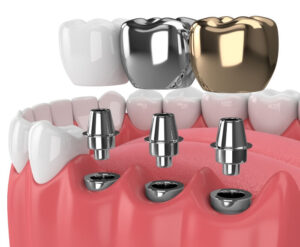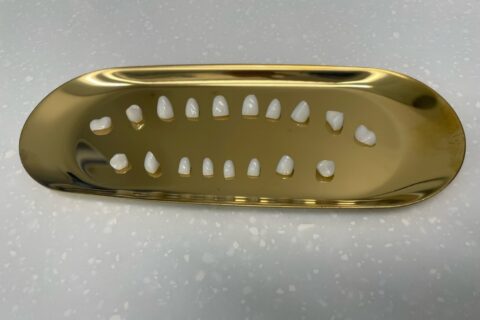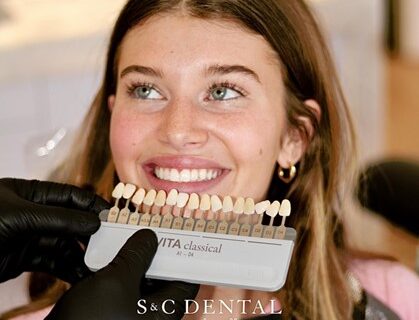What Are Dental Implants Made of and What Are the Different Kinds
Discover Your Dental Implant Options in Scottsdale, AZ
Since their creation in 1965, dental implants have helped countless patients restore their smiles while improving their quality of life. Patients lose their teeth for natural reasons such as tooth decay, injury, infection, and more. We understand that patients may feel insecure about their smile when a tooth is missing. A dental implant is one of the most effective ways to replace a missing tooth. S&C Dental provides a wide selection of dental implant options for patients throughout Scottsdale, AZ. Our highly trained staff ensures your implant will look no different than your natural teeth but will be there to support your oral health for years. To learn more about our dental implant options, keep reading, or give our office a call.
Who’s The Ideal Candidate for Dental Implants?
Most healthy patients are great candidates for dental implants. However, we consider several factors to ensure the procedure is a success. Patients with bone density issues or autoimmune diseases affecting their body’s ability to heal may not be ideal candidates for this procedure. Here are some of the factors we review to determine if a patient is a good candidate:
- Have Good Oral Health
- Possess Adequate Bone Density to Anchor the Implant
- Free from Periodontal Disease
- Have Healthy Gum Tissue
Discover How Implants Are Placed
Before the procedure, our team will schedule you for a consultation, where we’ll check your periodontal health and determine if you need a bone grafting procedure, gum disease treatment, and more. If everything looks healthy, we’ll schedule a surgical procedure. For successful dental implantation, the patient must be sedated throughout the procedure. Once completed, your new implant will have a strong foundation and be durable enough to eat and brush normally. Here are the three general phases of placing an implant:
- Surgical Placement – Our first step is surgically placing the implant in the upper or lower jaw.
- Integration – Once placed, your new implant will need time to integrate with your jawbone fully. Depending on what materials you use, it affects the integration time. This ensures the implant and the jawbone have time to heal and grow, ensuring a robust and stable foundation.
- Placement of the Dental Crown – Your new dental crown will be placed. We’ll check the fit and ensure everything fits as it should.

What Are the Most Common Types of Dental Implants?
When it comes to implants, there are two main types of dental implants, endosteal and subperiosteal, and two main types of implant procedures, single-stage and two-stage. Regardless of the type and procedure, you’ll be left with natural-looking implants durable enough to withstand everyday life. We’ll work with you to help determine the best type and procedure for your needs. Take a look at an overview of the two main types of dental implants and procedures:
- Endosteal – Endosteal is the more common single-tooth implant and is the preferred option in our industry. With this type, the implant is anchored into the jawbone to act as an actual tooth root and is designed to resemble a small screw. This type is preferred because when a tooth is missing or removed, it can lead to bone loss while shifting adjacent teeth. Endosteal implants anchor a crown into the open tooth root to help preserve and support the face structure and jawbone.
- Subperiosteal – Subperiosteal resembles endosteal but is placed under the gum tissue or on top of your jawbone instead of being anchored into your jaw. This type of dental implant is commonly used for patients who don’t have enough solid or healthy jawbones to support an implant. We often recommend that our patients undergo a bone augmentation procedure to help strengthen and rebuild their jawbone to receive an endosteal implant. However, subperiosteal implants offer similar results if patients do not want to undergo bone augmentation.
- Single-Stage – As the name implies, single-stage implants only require one surgical procedure. During the procedure, a long implant is placed into your jaw and gum, exposing the top of the implant. When healed, we’ll attach your new crown. Single-stage procedures are for patients who have jawbone issues or special needs.
- Two-Stage – Unlike single-stage, two-stage procedures take longer to heal due to the need for at least two surgical procedures. During the first procedure, we’ll place your implant into your jawbone and stitch it to ensure it properly heals. After a few months, we’ll perform another minor surgery to expose the implant and place your new implant. While this procedure is more complex than single-stage, it provides more benefits. The time between placement and delivery ensures that the implant is as durable as a tooth root.
Alternative Types of Dental Implants
There are other techniques available that our dentists may recommend either in place of an implant or along with your dental implant. These additional options are designed to help improve traditional implant techniques such as endosteal or provide an alternative based on your needs. Here are some alternative implant techniques our team may use:
- Immediate Load Dental Implants – This technique places a temporary tooth onto the implant right after placement. Immediate load implants are only used if a patient has enough natural bone and the implant is secure.
- Mini Dental Implants – These implants are approximately the size of a toothpick. Mini implants are less invasive than traditional implants and are commonly used to help stabilize lower dentures. If a patient is missing most of their teeth and uses dentures, mini dental implants help keep their dentures in place. They’re not commonly used in place of traditional implants because they cannot withstand eating and chewing.
- All-On-4 Implants – All-on-4 implants are often the solution for patients missing their top or bottom teeth. When completed, this technique provides four titanium implants to support dentures. While they provide help and convenience to patients, they may not be suitable for everyone.

Explore the Different Types of Implant Materials
Thanks to advances in dental technology and research, implants can be made from various materials. These materials were selected for their durability and resistance to fracturing and deterioration while having highly specific microstructures and compositions. Each material comes with its own unique set of advantages and properties. Most commonly, dental implants are either made from titanium or zirconia. Still, other materials are used to make dental implants. Here is a breakdown of each material and the unique properties they each provide:
- Titanium – Without a doubt, titanium remains the gold standard for implant materials. It’s commonly used because it easily creates a permanent fixture in your jawbone. Titanium effortlessly fuses to the bone because it’s a biocompatible material. Titanium is highly sought-after due to its durability and provides long-lasting implants at a reasonable price. Most titanium implants are made from titanium alloys, which allows the implants to be stronger and safer.
- Zirconia – Zirconia is a relatively recent addition to dental materials. While it holds much promise, zirconia is for patients with a metal allergy. Unlike titanium, it could also help make surgical procedures easier due to a one-piece construction.
- Polymers – Polymers are ideal for dental implants due to how easily their composition can be altered. This allows for a more visually pleasing appearance. Unlike titanium and zirconia, polymers aren’t as durable.
- Ceramics – Certain ceramics, like carbon silicon, can be used to create dental implants. Ceramics offer durable and robust advantages but are known to have some brittle properties. This can limit their ability to offer long-lasting tooth replacement solutions.
- Alternative Metals – Metals other than titanium can be used to create implants. The most common alternative metals include stainless steel, gold, and cobalt-chromium. They offer advantages such as increased durability while being resistant to corrosion. They have a lower success rate than titanium, so they’re less commonly used.
Take Advantage of Our Dental Implant Options
Dental implants can help patients regain their smiles and confidence while improving their quality of life. The team at S&C Dental offers a wide variety of high-quality dental solutions using the latest techniques and state-of-the-art technology. Our experience allows us to provide exceptional care with a personalized touch. Whether you’re looking for cosmetic dentistry or need our emergency dental services, we’ll work to ensure you get the care you deserve. To learn more about our services, don’t hesitate to give us a call. One of our knowledgeable representatives will be standing by to help answer your questions or get you scheduled.


